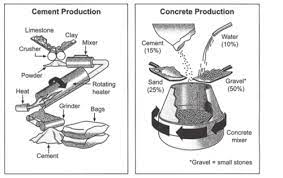» You should spend about 20 minutes on this task.
The diagram below shows the stages and equipment used in the cement-making process, and how cement is used to produce concrete for building purposes.Summarise the information by selecting and reporting the main features and make comparisons where relevant.
» You should write at least 150 words.

Sample Answer 1
The given diagram shows the process of cement production and then how this cement is used for concrete production. As is observed from the graph, cement production involves some complex processes and concrete production is done using the water, cement and sand in a concrete mixer.
The first diagram depicts that, to produce cement first the limestone and clay are crushed and the produced powder from this is passed through a mixer. The power is then passed via a rotating heater where heat is supplied constantly and this process creates the raw cement materials which are passed on a grinder machine to finally produce the cement. The cement is then packed and marketed for sale.
The second diagram presents how the concrete is produced for housing and building work. In the first stage, 15% cement, 10% water, 25% sand and 50% small stones are mixed in a concrete mixer machine and the machine rotates fast to have the ingredients mixed together to create the concrete.
Sample Answer 2
The two diagrams illustrate the cement-making process. We can see from the given illustration that cement is manufactured first, and then it’s used in the concrete production.
In the first diagram, we can see that limestone is the raw material with which clay added. Firstly, the two materials are crushed to form the powder. Then this powder passes through a mixer and a heater through which the powder is exposed to flame. The powder now is in the form of a paste. This paste is grinded to be cement to pass through the last process; packing in bags.
The second diagram shows that cement can be used to produce concrete. This process is simpler than cement production; concrete is a mixture of 15% cement, 10 % water, 25% sand and 50 % small stones which are named as “Gravel”. The four elements are poured in a huge mixer which rotates producing concrete. We can see that once the cement is produced by several steps and equipment, it can be used in other less complicated processes, for instance, concrete production.
(Submitted by Abdullah Hassan)
Sample Answer 3
These two diagrams reveal the flow diagrams of both cement and concrete production processes with necessary equipment and materials that are used. Mainly, both processes have similarities and differences. They are similar because each of them has more than one input and a single output. On the other hand, they differ in the number of production steps.
In the cement production diagram, firstly, limestone and clay are gathered and passed through a crusher. Then, the powder obtained from crusher is moved to the mixer to make a homogene mixture. Next, rotating heater welcomes the material from the mixer. After heating step, resulting material flows on the grinder. Finally, cement becomes ready to be packed in bags at the end of the grinder.
In the concrete production diagram, the process contains only one step to have concrete material that is mixing. Cement, water, sand and gravel which is a general name for small stones are all mixed in a rotating concrete mixer in precise proportions such as 15%, 10%, 25% and 50% respectively.
(Submitted by Hüsna Uçar)
Sample Answer 4
The diagrams illustrate how cement is produced and also an example of cement utilisation produced to make concrete to use in a form of construction.
To begin with, cement is produced by combining raw materials like limestone, clay, which are processed in a tool called crusher. Those all items are mixed together to create a perfect blend. The blend, furthermore, goes into to a rotating heater. As it is in the rotating heater tube, heat is introduced from the end of the tube before the blend is actually dropped onto grinder. Then, after all the systemic process, the mixture turns into some cement which is then packed into bags.
Meanwhile, to create concrete, the main components of construction systems are gravel, cement, water, sand and a concrete mixer to blend all the materials. Gravel or small stone is the major and biggest component needed and accounts for 50% among all materials. There are, however, some other materials like the sand which is mainly used and comes in the second place and is accounted halved from gravel, followed by cement and water. The cement accounts for 15% compared to among all materials used to construct a new real construction. All the material is mixed together by a concrete mixer.
Overall, the steps of making cement are more complicated and require advanced machinery while concrete production requires mixing required components in the right proportion in a simpler machine. While heat is required to produce cement, no heat penetration during the combination period of making concrete is required.
(Submitted by Linda)
